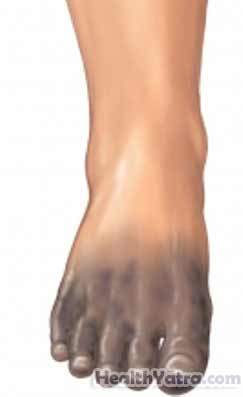সংজ্ঞা
Surgical removal of a toe, foot, or part of a foot
পদ্ধতির কারণ
Amputation is most often done to:
- Treat infections
- Remove dead or damaged tissue, such as gangrene may cause

সম্ভাব্য জটিলতা
Complications are rare, but no procedure is completely free of risk. If you are planning to have an amputation, your doctor will review a list of possible complications, which may include:
- Difficulty healing
- সংক্রমণ
- Stump pain (severe pain in the remaining tissue)
- Phantom limb pain (a painful sensation that the foot or toe is still there)
- Continued spread of gangrene, requiring amputation of more areas of your foot, toes, or leg
- রক্তপাত
- নার্ভ ক্ষতি
- Limp (depending on which toe has been removed)
- Contracture deformity
জটিলতার ঝুঁকি বাড়াতে পারে এমন কারণগুলির মধ্যে রয়েছে:
- ধূমপান
- সংক্রমণ
- Poorly controlled diabetes
- দুর্বল রক্ত সঞ্চালন
- রক্তপাতের ব্যাধি
- Heart problems or high blood pressure
- ধূমপান
- কিডনি ব্যর্থতা
- স্থূলতা
- উন্নত বয়স
কি আশা করছ
পদ্ধতির আগে
Before the surgery, your doctor may do some of the following:
- রক্ত পরীক্ষা
- X-ray of toe and foot
- Bone scan to see if the bone is infected
- Tests to evaluate blood circulation and help the doctor determine how much of the foot or toe needs to be amputated
Talk to the doctor about the medicines you are taking. You may be asked to adjust the dose or stop taking certain medicines, such as:
- Aspirin or other anti-inflammatory drugs (may need to stop up to one week before)
- Blood-thinning medicines, such as:
- ক্লোপিডোগ্রেল (প্লাভিক্স)
- Warfarin (Coumadin)
- Ticlopidine (Ticlid)
In the days leading up to your surgery:
- হাসপাতালে আসা-যাওয়ার ব্যবস্থা করুন।
- Arrange for help at home after the surgery.
- আগের রাতে হালকা খাবার খান। খাওয়া বা মধ্যরাত্রি পরে কিছু পান করবেন না।
- You may be asked to shower the morning of your procedure. You may be asked to use a special antibacterial soap.
এনেস্থেশিয়া
Based on your surgery and general health, you may have:
- General anesthesia —You will be asleep.
- Local anesthesia—The area that is being operated on will be numbed.
- Spinal anesthesia —Medicine is delivered to the spine to numb the lower body.
পদ্ধতির বর্ণনা
You will be given IV fluids and antibiotics. Your foot will be washed with an antibacterial solution. The surgeon will make an incision into the skin around the area. The blood vessels will be tied off or sealed with an electrical current. This will prevent bleeding. The involved bones will be removed.
The ends of the remaining bone(s) will be smoothed. The remaining skin and muscle will be pulled over the open area. It will be closed with stitches. A sterile dressing will then be placed over the incision.
If there is an active infection, tubes may be left in place to allow fluids to drain. In some cases, the skin will not be closed but will instead be packed with a moist dressing.

mmediately After Procedure
You will be taken to a recovery room. There, you will be monitored for any negative effects from the surgery or anesthesia. You will be given pain medicine. You may also receive antibiotic medicines.
এতে কতক্ষণ সময় লাগবে?
20-60 minutes
এটা কতটা আঘাত করবে?
Anesthesia prevents pain during surgery. The area will be painful after the surgery. You will be given medicine to help control the pain.
গড় হাসপাতালে থাকার
The usual length of stay is 2-7 days. Your doctor may choose to keep you longer if complications arise.
পোস্ট-প্রক্রিয়া যত্ন
হাসপাতালে
- Your foot will be kept elevated.
- The toe or foot will be wrapped with a bulky dressing. This will protect it from injury.
- You will be encouraged to get up and begin walking as soon as the wound allows.
- A physical therapist will likely assist you in walking at first.
ঘরে
আপনি যখন বাড়িতে ফিরে আসবেন, একটি মসৃণ পুনরুদ্ধার নিশ্চিত করতে নিম্নলিখিতগুলি করুন:
- You may need to wear a cast, a special postoperative shoe, or a regular shoe with the foot box removed until the stitches are taken out. Stitches will be removed in about three weeks.
- কখন গোসল করা, গোসল করা বা জলে ভিজানো নিরাপদ সে সম্পর্কে আপনার ডাক্তারকে জিজ্ঞাসা করুন।
- You may be advised to begin an exercise, physical therapy, or rehabilitation program.
- If you are a smoker, you should quit.
- Be sure to follow your doctor’s instructions about activity and medicines.
আপনার ডাক্তারকে কল করুন
আপনি হাসপাতাল ছেড়ে যাওয়ার পরে, নিম্নলিখিতগুলির মধ্যে যেকোনটি ঘটলে আপনার ডাক্তারের সাথে যোগাযোগ করুন:
- জ্বর এবং ঠাণ্ডা সহ সংক্রমণের লক্ষণ
- লালভাব, ফোলাভাব, ক্রমবর্ধমান ব্যথা, অত্যধিক রক্তপাত, বা ছেদ স্থান থেকে কোনো স্রাব
- Chalky white or blackish appearance of foot, other toes, or leg
- Decreased sensation, numbness, or tingling in the rest of your foot, toes, or leg
- Nausea and/or vomiting that you cannot control with the medicines you were given after surgery, or that persist for more than one day after discharge from the hospital
- ব্যথা যা আপনি ওষুধ দিয়ে নিয়ন্ত্রণ করতে পারবেন না
- Pain, burning, urgency or frequency of urination, or blood in the urine
- কাশি, শ্বাসকষ্ট বা বুকে ব্যথা
- জয়েন্টে ব্যথা, ক্লান্তি, শক্ত হওয়া, ফুসকুড়ি বা অন্যান্য নতুন উপসর্গ
জরুরী পরিস্থিতিতে, অবিলম্বে চিকিৎসা সহায়তার জন্য কল করুন।
